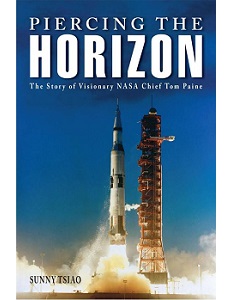On his watch as NASA’s third Administrator, Thomas O. Paine, saw seven Apollo missions in Earth orbit and five reach the Moon; and in 1985, at President Reagan’s request, he chaired the first-ever National Commission on Space. This biography of Paine inaugurates the publisher’s new series of ‘Studies in Aeronautics and Astronautics’ which, if nothing else, proves that publishers are still learning the attraction of space topics. As a Foreword by the Series Editor points out, there have been many astronaut biographies but “too few critical works on the principal managers and bureaucrats” responsible for the US space programme.
This biography traces Tom Paine’s life from his upbringing as a “Navy Brat” (his father had a “distinguished 30-year career in the Navy”), via war service, to his contributions to America’s space programme. The volume includes 50 pages of chapter notes, a bibliography and an index and is written in a fluid and entertaining style. It is illustrated by a 32-page photo-insert in black-and-white and colour.
The author reveals that he made a conscious decision to concentrate on Paine’s personal as opposed to corporate files, which no doubt sets the tone of the book. It tells the story of a man who took on roles of great responsibility but, as a result, got caught up in the politics of the times.
For example, in March 1986, the fabled National Commission report – “Pioneering the Space Frontier” – was ready to present to the president; but the White House “unexpectedly postponed the appointment”… and three days later began airstrikes on Libya in retaliation for a terrorist bombing of West Berlin. It took three months to reschedule the presentation.
Another incident shows what a political operator Paine was, or had to be given the situation. Ted Kennedy, who the author describes as “NASA’s biggest critic in Congress”, had chosen a memorial banquet for the late rocket pioneer Robert Goddard to criticise the country’s manned space programme, at a time when the Apollo 10 astronauts were orbiting the Moon. In response, Paine used an Apollo press conference to express his surprise and disappointment at the senator’s “dispiriting vision of this nation’s vigor and destiny in space”.
Paine continued to contribute to the space community until his death in 1992; later that year NASA launched its Mars Observer spacecraft on a rocket inscribed with the words “United States Spaceship Thomas O. Paine Departed Earth September 1992”. As the author reports, that upper stage now circles the Sun “on a timeless journey around the solar system” - a fitting memorial indeed.
Shortly after splashdown, Paine visited Kennedy to “propose a truce”, offering the gesture of leaving a personal memento of JFK (a tie-clip) on the lunar surface during the Apollo 11 mission. Teddy was not cooperative and Paine soon realised that “the Kennedys had no real interest in identifying JFK with America’s moon program”, preferring to treat it as an “aberration in the late president’s legacy”. Apparently, senator Kennedy would continue to oppose Paine throughout his whole career.











